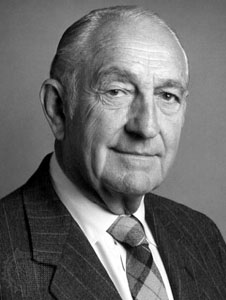David Packard facts for kids
Quick facts for kids
David Packard
|
|
|---|---|
 |
|
| 13th United States Deputy Secretary of Defense | |
| In office January 24, 1969 – December 13, 1971 |
|
| President | Richard Nixon |
| Preceded by | Paul Nitze |
| Succeeded by | Kenneth Rush |
| Personal details | |
| Born | September 7, 1912 Pueblo, Colorado, U.S. |
| Died | March 26, 1996 (aged 83) Stanford, California, U.S. |
| Spouse | Lucile Salter (d. 1987) |
| Children | 4 including David, Susan, and Julie |
| Education | Stanford University (BA, MA) |
| Known for | Co-founder of Hewlett-Packard. Member of Trilateral Commission. |
| Awards | Sylvanus Thayer Award (1982) Presidential Medal of Freedom (1988) Public Welfare Medal (1989) |
David Packard (born September 7, 1912 – died March 26, 1996) was an American electrical engineer. He is best known as the co-founder of Hewlett-Packard (HP) with his friend Bill Hewlett. Packard was a leader at HP for many years, serving as its president, CEO, and chairman.
He also worked for the United States government as the Deputy Secretary of Defense from 1969 to 1971. David Packard was recognized for his many new ideas in technology and for his generous acts of giving back to the community.
Contents
David Packard's Early Life and Education
David Packard was born in Pueblo, Colorado. His father, Sperry Sidney Packard, was a lawyer. From a young age, David showed a strong interest in science and engineering. He also enjoyed sports and was a natural leader.
Packard went to Stanford University and earned his bachelor's degree in 1934. While at Stanford, he played football and basketball. He also met two very important people there: Lucile Salter, who would become his wife, and Bill Hewlett, his future business partner.
After college, Packard worked for the General Electric Company for a short time. In 1938, he returned to Stanford and earned a master's degree in electrical engineering. That same year, he married Lucile Salter. They had four children together: David, Nancy, Susan, and Julie. Lucile passed away in 1987.
Starting Hewlett-Packard (HP)
In 1939, David Packard and Bill Hewlett started their company, Hewlett-Packard (HP). They began in Packard's garage with only $538. They decided the company name by flipping a coin, which is why it's Hewlett-Packard and not Packard-Hewlett!
Their very first product was an audio oscillator. This device helps create sound waves. One of their first big customers was Walt Disney Studios. Disney used their oscillators to make the soundtrack for the famous movie Fantasia.
Over the years, HP grew into a huge company. It became a world leader in making electronic testing devices. HP also became well-known for producing calculators, computers, and different types of printers.
HP officially became a company in 1947. David Packard was its first president until 1964. He then became the Chief Executive Officer (CEO) and Chairman of the Board. He left HP for a few years to work for the government. When he returned in 1972, he became Chairman of the Board again until 1993.
Packard helped guide HP through many changes and successes. When he passed away in 1996, his share in the company was worth over $1 billion. HP was also one of the very first companies to register its own internet address, "HP.com," back in 1986.
Serving His Country
In 1969, President Richard Nixon asked David Packard to serve as the U.S. Deputy Secretary of Defense. This meant he was the second-highest leader in the country's defense department.
While working for the government, Packard used his business knowledge to help improve how the military managed its resources. He worked to make things more efficient, just like he did at HP. He also helped create the Defense Systems Management College, which teaches military leaders about management.
Packard left his government role in 1971 and returned to HP. He continued to advise the White House on defense matters in the 1970s and 1980s.
Giving Back: Philanthropy
David Packard was very generous with his time and money. From the 1980s until he passed away, he focused a lot on philanthropy, which means giving money and time to help others.
In 1964, David and his wife Lucile started the David and Lucile Packard Foundation. This foundation supports many different causes. In 1986, they gave $40 million to build the Lucile Packard Children's Hospital at Stanford University, which opened in 1991.
Inspired by their daughters, David and Lucile also created the Monterey Bay Aquarium Foundation in 1978. They donated $55 million to build the aquarium, which opened in 1984. Their daughter Julie Packard became its executive director. Later, in 1987, Packard gave $13 million to create the Monterey Bay Aquarium Research Institute, which studies ocean life.
In 1994, Packard and Bill Hewlett together donated $77 million to Stanford University. In honor of David Packard, the university named the Electrical Engineering Building after him.
When David Packard passed away in 1996, he left most of his wealth, about $4 billion, to the David and Lucile Packard Foundation. His children continue to be involved in the foundation's work.
Awards and Recognition
David Packard received many awards for his achievements:
- IEEE Founders Medal (1973)
- Sylvanus Thayer Award (1982)
- National Medal of Technology (1988)
- Presidential Medal of Freedom (1988)
- Public Welfare Medal (1989)
- Lemelson-MIT Prize (1995)
- Member of the California Hall of Fame (2006)
Packard's old home and garage in Palo Alto, California are now recognized as a historic place. They are known as "The Birthplace of Silicon Valley" because that's where HP, one of the first big tech companies, began.
See also
 In Spanish: David Packard para niños
In Spanish: David Packard para niños

